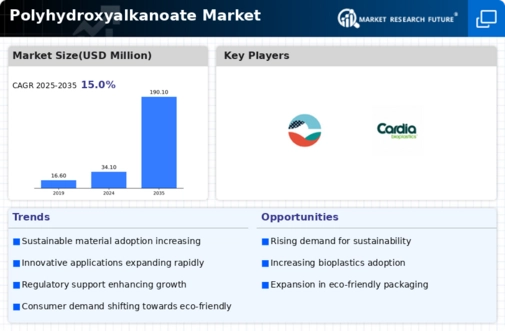Market Analysis
In-depth Analysis of Polyhydroxyalkanoate Market Industry Landscape
The polyhydroxyalkanoate (PHA) market is experiencing dynamic shifts driven by various factors influencing supply, demand, and pricing. PHA is a biodegradable polymer derived from renewable resources, making it an attractive alternative to conventional plastics. Market dynamics in the PHA industry are shaped by several key factors, including technological advancements, regulatory policies, consumer preferences, and competitive landscape.
The Polyhydroxyalkanoate Market is differentiated into Type, Technology and Application. Market by type is fragmented as Polyhydroxyalkanoate and polyhydroxybutyrate blended with co-polymers. Polyhydroxybutyrate Polymers are produced by biological degradation of microorganisms.
Technological advancements play a significant role in shaping the PHA market dynamics. As research and development efforts continue to improve PHA production processes, the cost-effectiveness and scalability of PHA manufacturing are expected to increase. Innovations in microbial fermentation techniques, genetic engineering, and bioprocess optimization have contributed to the commercial viability of PHA production, driving market growth.
Regulatory policies also exert a significant influence on the PHA market dynamics. With increasing concerns over environmental pollution and plastic waste, governments worldwide are implementing regulations and initiatives to promote the use of biodegradable plastics like PHA. These regulatory measures include bans on single-use plastics, incentives for bioplastics adoption, and mandates for sustainable packaging solutions. Compliance with regulatory requirements and alignment with sustainability goals are key drivers shaping market dynamics in the PHA industry.
Consumer preferences and awareness are driving demand for eco-friendly alternatives, including PHA-based products. As consumers become more environmentally conscious, there is a growing demand for sustainable packaging, biodegradable plastics, and green alternatives to traditional materials. Companies are responding to these changing preferences by incorporating PHA into their product portfolios and promoting the environmental benefits of PHA-based solutions. This shift in consumer behavior is driving market growth and influencing product innovation in the PHA industry.
The competitive landscape also plays a crucial role in shaping market dynamics in the PHA industry. With increasing interest from both established players and new entrants, the market is becoming more competitive. Companies are investing in research and development, strategic partnerships, and mergers and acquisitions to gain a competitive edge and expand their market presence. This competition drives innovation, drives down costs, and fosters market growth, while also creating challenges for market incumbents to maintain their market share.
Market dynamics in the PHA industry are characterized by fluctuations in supply and demand, which in turn, influence pricing trends. As production capacities expand and technological advancements drive down production costs, the supply of PHA is expected to increase, leading to downward pressure on prices. However, demand-side factors such as regulatory mandates, consumer preferences, and sustainability initiatives can counteract this downward pressure and support stable or even increasing prices for PHA products.





Leave a Comment